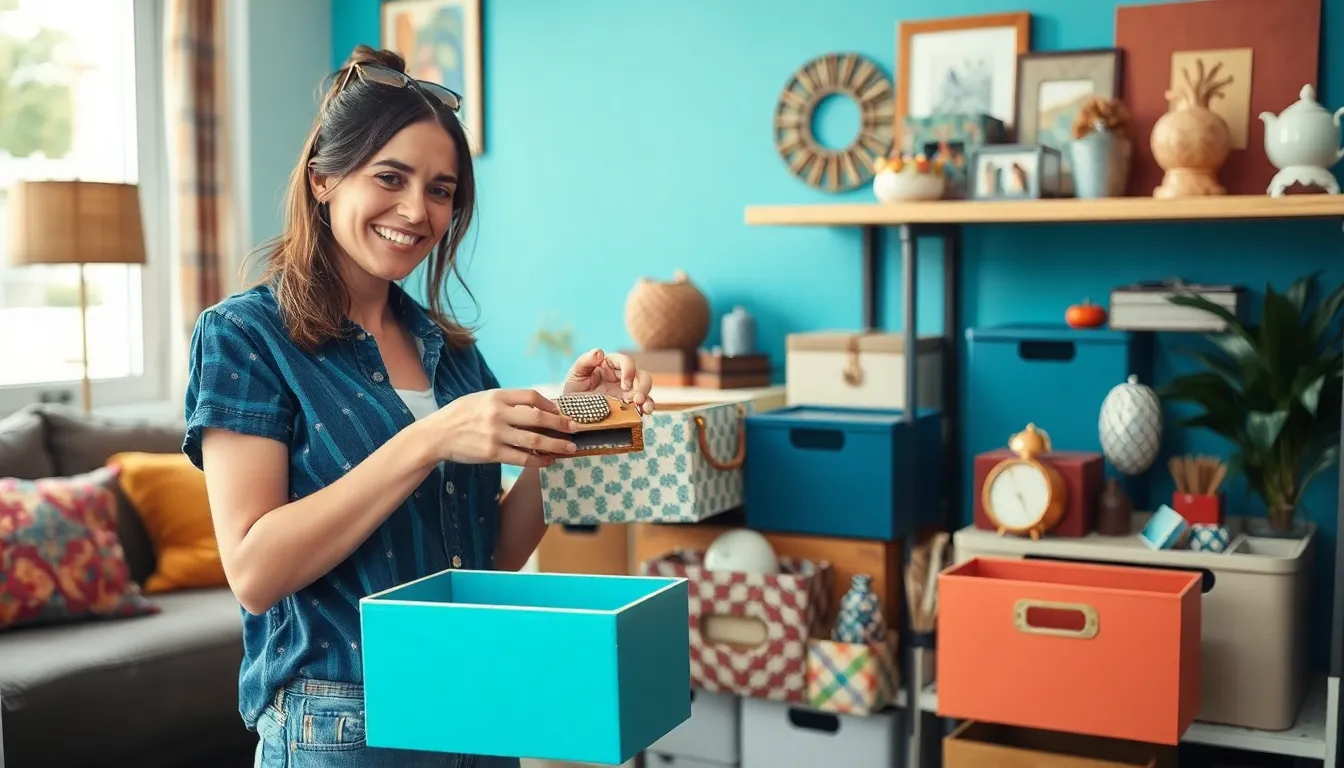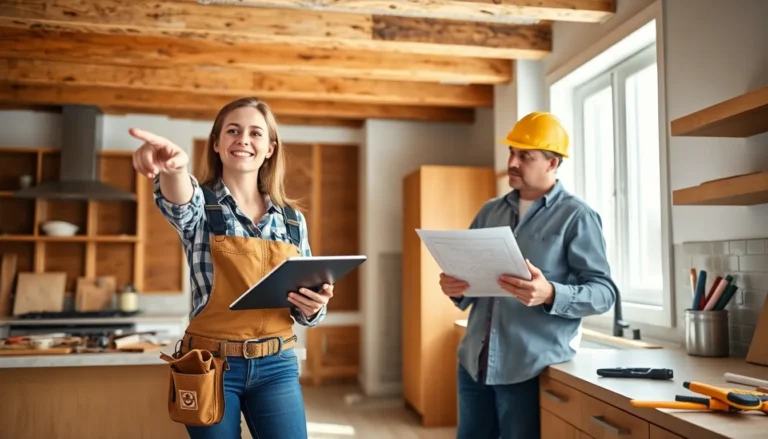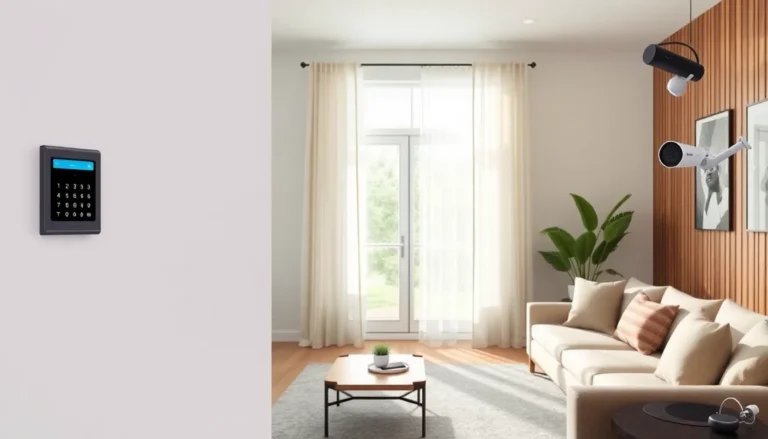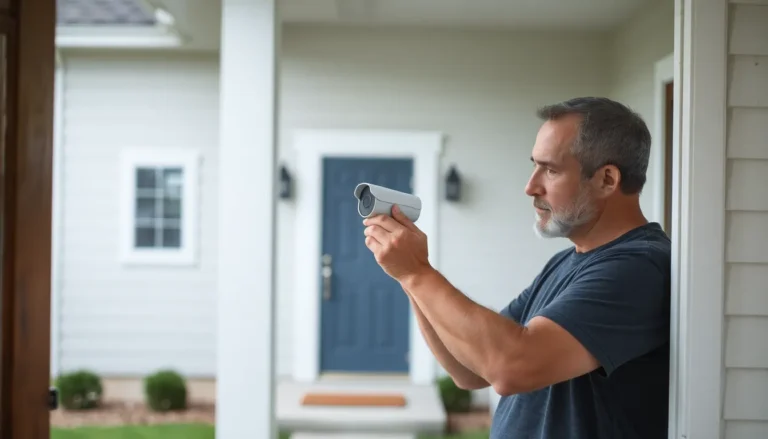Cluttered spaces can feel like a never-ending episode of a reality show gone wrong. If piles of paperwork and random knick-knacks are taking over, it’s time to reclaim that territory. DIY organizing isn’t just about tidying up; it’s a creative adventure that transforms chaos into calm. Who knew that turning your mess into a masterpiece could be this fun?
Table of Contents
ToggleWhat Is DIY Organizing?
DIY organizing refers to the self-driven process of arranging spaces using creative techniques. This approach allows individuals to take control of their environment, transforming chaotic areas into organized havens.
Definition and Concepts
DIY organizing involves creating functional and aesthetically pleasing spaces. It includes utilizing available materials and tools to design custom storage solutions. Popular strategies encompass decluttering, repurposing items, and optimizing space. This concept encourages personal expression while addressing specific organizational needs.
Importance in Everyday Life
Engaging in DIY organizing significantly enhances overall quality of life. Organized spaces promote efficiency, making it easier to find necessary items. Clutter reduction often leads to reduced stress and increased focus. Moreover, maintaining organization fosters habits that contribute to long-term tranquility in daily routines. Improvements typically encourage creativity and productivity, ultimately enriching personal well-being.
Benefits of DIY Organizing

DIY organizing presents numerous advantages, enriching both spaces and lives. The following sections explore key benefits in more detail.
Cost-Effectiveness
Cost savings stand out as a significant benefit of DIY organizing. Individuals avoid expensive professional services by taking a hands-on approach. Customized solutions emerge by repurposing items or using low-cost materials. Budget-friendly options enable creativity without overspending. Many DIY projects require just common household items, making organizing accessible for everyone. Savings can be substantial, with potential reductions of hundreds of dollars compared to hiring professionals. Emphasizing resourcefulness often leads to cost-efficient and effective organization.
Personalization
Personalization plays a vital role in DIY organizing. Spaces become true reflections of individual tastes and lifestyles through custom solutions. Each person can design systems that cater specifically to their needs. This unique approach fosters a sense of ownership and pride. Choices in colors, styles, and layouts enhance both functionality and aesthetics. Moreover, engaging in the design process sparks creativity and enjoyment. Ultimately, DIY organizing empowers individuals to create spaces that inspire and motivate.
Popular DIY Organizing Ideas
Many individuals embrace DIY organizing to create functional and visually appealing spaces. These ideas encompass various areas of the home, each with unique solutions.
Closet Organization
Maximizing closet space requires creative approaches. Implement shelf dividers to create designated areas for clothes, shoes, and accessories. Utilize hanging organizers for small items like belts, ties, and jewelry. Consider using clear bins for easy visibility of seasonal clothing. Vertical storage options, such as hooks or cascading hangers, optimize the available height. Regularly reassessing and decluttering ensures closets remain tidy and efficient.
Kitchen Hacks
Transforming kitchens into organized culinary havens starts with smart storage solutions. Installing magnetic strips for spice jars keeps them visible and accessible. Drawer dividers can help maintain order among utensils and kitchen gadgets. Use baskets to corral snacks or even fruits and vegetables on countertops. Labels on containers provide clarity on food items and promote easy access. Adding a pegboard behind cabinets maximizes wall space for pots and pans, ensuring everything has a designated place.
Home Office Solutions
Creating an efficient home office involves tailored organizing strategies. Desk organizers can contain pens, notepads, and essential tools for quick access. Floating shelves allow for effective use of wall space while displaying books or decor items. Cable management systems keep cords orderly and reduce visual clutter. Using labeled file boxes keeps documents and important papers categorized. Regular decluttering of workspaces fosters an inspiring environment, enhancing focus and productivity.
Tools and Materials for DIY Organizing
Effective DIY organizing requires the right tools and materials. These items enhance creativity and streamline the organizing process.
Essential Tools
A tape measure allows individuals to assess space accurately. Utility knives facilitate cutting various materials for customized solutions. Scissors help with smaller adjustments and paper items. Screwdrivers assist in assembling or disassembling storage units. A level ensures that installations remain straight and visually pleasing. Magnetic strips provide versatile storage options for metal items. By incorporating these essential tools, users can tackle any organizing project with ease.
Recommended Materials
Wooden crates serve as stylish storage options and add a rustic touch. Bins with clear labels make items easily identifiable and accessible. Drawer organizers help maintain order in clutter-prone areas. Wire baskets offer ventilation, making them ideal for items like fruits or vegetables. Adhesive hooks enable users to maximize vertical space for accessories or tools. Fabric boxes add a soft element while keeping spaces organized. Selecting these materials enhances function and aesthetics in any area.
Tips for Effective DIY Organizing
Effective DIY organizing starts with targeted planning and preparation to achieve optimal results.
Planning and Preparation
Begin by assessing the area that requires organization. Identify clutter hotspots and determine what items truly belong in each space. Creating a detailed list of goals enhances focus and direction. Gather necessary tools and materials before embarking on the project, ensuring all items are handy. Assess existing storage solutions and think about how to repurpose them. Aim to visualize the desired outcome to foster motivation. Prioritizing tasks based on complexity promotes efficient progress. Organizing by categories simplifies decision-making for belongings and enhances productivity.
Maintenance Strategies
Establishing a regular maintenance routine is crucial for sustaining organization. Schedule time each week to evaluate and declutter spaces, preventing buildup. Setting specific zones for items encourages returns to their rightful places. Implementing a one-in-one-out rule helps manage new additions by eliminating unused items. Create a clear system for seasonal items, ensuring easy access during appropriate times of the year. Encouraging family members or roommates to participate in upkeep fosters shared responsibility. Using visual reminders, such as checklists, reinforces habits that support long-term organization.
Embracing DIY organizing transforms cluttered spaces into serene environments that reflect personal style. This hands-on approach not only saves money but also fosters creativity and ownership over one’s space. By utilizing practical tools and materials, individuals can craft tailored solutions that enhance functionality and aesthetics.
Regular maintenance and smart strategies ensure that organized spaces remain efficient and inspiring. As individuals take charge of their surroundings, they cultivate habits that promote long-term tranquility and productivity. Ultimately, DIY organizing is about more than just tidying up; it’s a journey towards a more harmonious and fulfilling living experience.



